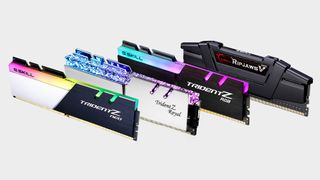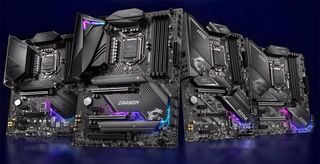G.skill launches extreme low-latency memory that's ideal for AMD Ryzen gaming PCs
Sure to offer the high performance and high capacity that high-end gaming PCs crave.

G.Skill has announced two brand new kits of extreme low-latency DDR4-3600 memory—a 32GB kit smack bang in the sweet spot for gaming and a 64GB kit for memory-heavy applications, such as content creation.
The new low-latency memory kits will be rated to CL14-15-15-35, which matches the Team Extreem ARGB C14 kits currently sitting atop of our best RAM for gaming guide. G.Skill will be offering its extreme low-latency kits under its Trident X Neo, Trident Z Royal, Trident Z RGB, and Ripjaws V series—plenty of options from bling to bare.
All kits are built using Samsung B-Die chips, a fan favourite for overclocking.

Best gaming motherboard: the best boards around
Best AMD motherboard: your new Ryzen's new home
Fitting the criteria for AMD Ryzen Zen 2 perfectly, the new kits from G.Skill will be a dab hand for AMD Ryzen builds. As you can see in Chris Szewczyk's performance testing across multiple RAM speeds, a heady mix of both frequency and low latency offers the most consistently high performance in a range of games.
The new AMD Ryzen 5000 processors are reportedly going to run at their best at 4,000MHz (effective) but there's unlikely to be much in it between that and a low-latency 3,600MHz kit. Similarly, Intel systems don't care quite as much for memory speed and latency, but even so low-latency kits often outperform those with 1GHz+ higher frequencies.
A 16GB kit is currently the go-to choice for gaming PCs, but if you want to keep your PC a little ahead of the game, it's a good time to pick up a 32GB kit as they're often going for as little as 16GB kits were just a year back. The higher capacity will ensure you're more than equipped for future games and memory hogs, and it's really satisfying to fill all four motherboard memory slots.
The biggest gaming news, reviews and hardware deals
Keep up to date with the most important stories and the best deals, as picked by the PC Gamer team.

Jacob earned his first byline writing for his own tech blog. From there, he graduated to professionally breaking things as hardware writer at PCGamesN, and would go on to run the team as hardware editor. He joined PC Gamer's top staff as senior hardware editor before becoming managing editor of the hardware team, and you'll now find him reporting on the latest developments in the technology and gaming industries and testing the newest PC components.
Most Popular





